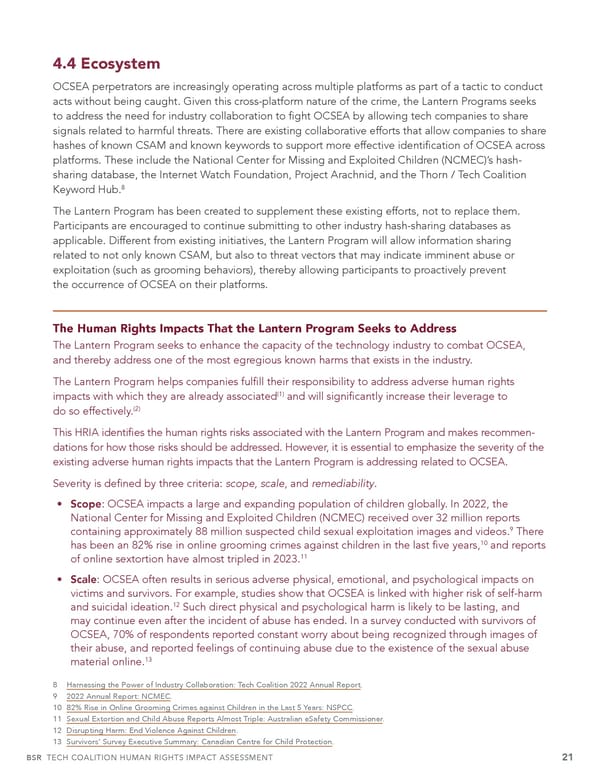4.4 Ecosystem OCSEA perpetrators are increasingly operating across multiple platforms as part of a tactic to conduct acts without being caught. Given this cross-platform nature of the crime, the Lantern Programs seeks to address the need for industry collaboration to 昀椀ght OCSEA by allowing tech companies to share signals related to harmful threats. There are existing collaborative efforts that allow companies to share hashes of known CSAM and known keywords to support more effective identi昀椀cation of OCSEA across platforms. These include the National Center for Missing and Exploited Children (NCMEC)’s hash- sharing database, the Internet Watch Foundation, Project Arachnid, and the Thorn / Tech Coalition Keyword Hub.8 The Lantern Program has been created to supplement these existing efforts, not to replace them. Participants are encouraged to continue submitting to other industry hash-sharing databases as applicable. Different from existing initiatives, the Lantern Program will allow information sharing related to not only known CSAM, but also to threat vectors that may indicate imminent abuse or exploitation (such as grooming behaviors), thereby allowing participants to proactively prevent the occurrence of OCSEA on their platforms. The Human Rights Impacts That the Lantern Program Seeks to Address The Lantern Program seeks to enhance the capacity of the technology industry to combat OCSEA, and thereby address one of the most egregious known harms that exists in the industry. The Lantern Program helps companies ful昀椀ll their responsibility to address adverse human rights (1) impacts with which they are already associated and will signi昀椀cantly increase their leverage to do so effectively.(2) This HRIA identi昀椀es the human rights risks associated with the Lantern Program and makes recommen- dations for how those risks should be addressed. However, it is essential to emphasize the severity of the existing adverse human rights impacts that the Lantern Program is addressing related to OCSEA. Severity is de昀椀ned by three criteria: scope, scale, and remediability. • Scope: OCSEA impacts a large and expanding population of children globally. In 2022, the National Center for Missing and Exploited Children (NCMEC) received over 32 million reports 9 containing approximately 88 million suspected child sexual exploitation images and videos. There 10 and reports has been an 82% rise in online grooming crimes against children in the last 昀椀ve years, 11 of online sextortion have almost tripled in 2023. • Scale: OCSEA often results in serious adverse physical, emotional, and psychological impacts on victims and survivors. For example, studies show that OCSEA is linked with higher risk of self-harm 12 Such direct physical and psychological harm is likely to be lasting, and and suicidal ideation. may continue even after the incident of abuse has ended. In a survey conducted with survivors of OCSEA, 70% of respondents reported constant worry about being recognized through images of their abuse, and reported feelings of continuing abuse due to the existence of the sexual abuse material online.13 8 Harnessing the Power of Industry Collaboration: Tech Coalition 2022 Annual Report. 9 2022 Annual Report: NCMEC. 10 82% Rise in Online Grooming Crimes against Children in the Last 5 Years: NSPCC. 11 Sexual Extortion and Child Abuse Reports Almost Triple: Australian eSafety Commissioner. 12 Disrupting Harm: End Violence Against Children. 13 Survivors’ Survey Executive Summary: Canadian Centre for Child Protection. BSR TECH COALITION HUMAN RIGHTS IMPACT ASSESSMENT 21
 Tech Coalition Human Rights Impact Assessment of the Lantern Program Page 20 Page 22
Tech Coalition Human Rights Impact Assessment of the Lantern Program Page 20 Page 22